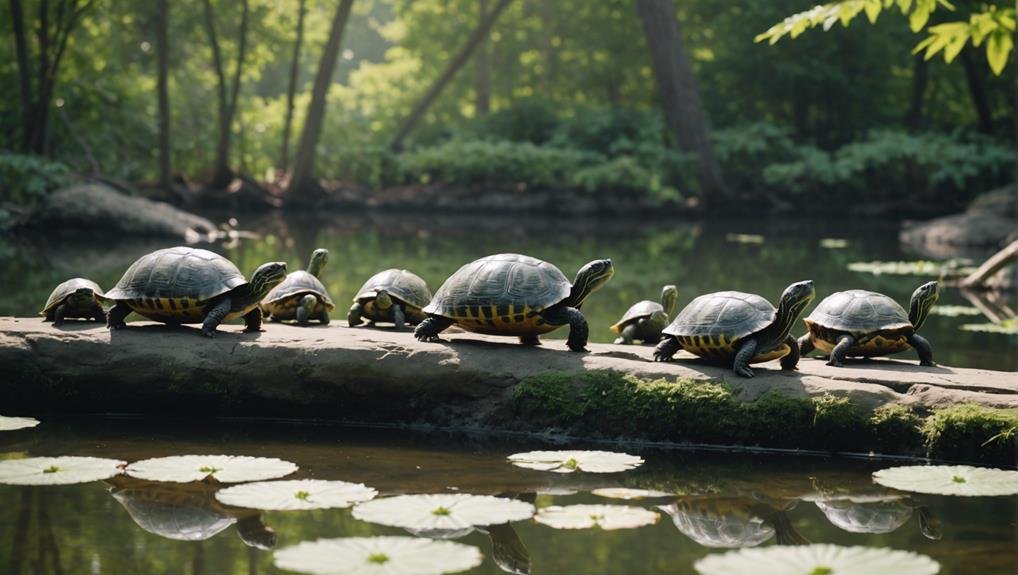You’ve probably never seen a turtle jump and are not alone. Given their heavy, shell-bound bodies, turtles are not equipped to ponder into the air like frogs or birds. However, it’s intriguing to contemplate how these creatures navigate their environments. Their movements might not include leaps or bounds, but turtles have unique skills suited to their survival. Have you ever wondered how these seemingly slow and steady animals move through complex terrains or evade predators? There might be more to their mobility than meets the eye, and the answers could change how you see these intriguing reptiles.
Key Takeaways
- Turtles cannot jump due to their heavy, rigid shell structure, which limits such movements.
- Their physical design is more suited for swimming or crawling, not jumping.
- The closest behaviour to jumping in turtles is a swift upward thrust of the head, particularly in aquatic species.
- Some species can climb or manoeuvre over obstacles, but actual jumping is beyond their capability.
- Understanding these limitations is crucial for providing appropriate habitats that don’t require jumping.
The Anatomy of Turtles
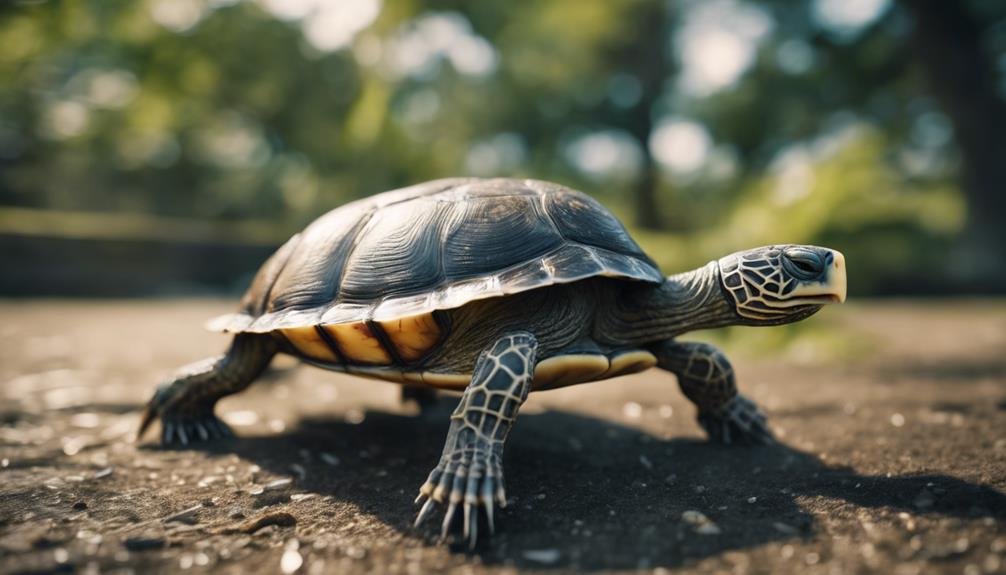

Turtles’ unique anatomy, characterized by a hard shell and a relatively rigid body, is essential to their mobility and overall survival. The shell isn’t just for defence; it’s integral to their life. The shell structure consists of two main parts: the carapace on the top and the plastron on the bottom. These are connected by bony structures called bridges, allowing for minimal flexibility but great protection.
Now, let’s explore their reproductive anatomy, which is quite fascinating. Unlike some reptiles, turtles’ reproductive organs are internal. The females have ovaries and oviducts, where the eggs are developed and pass through before being deposited. On the other hand, males also possess internal testes, typically retracting into the body to maintain a stable temperature necessary for sperm development.
Understanding these aspects is important as they influence their survival strategies, physical capabilities, and limitations. For instance, the rigid structure of the shell means turtles can’t expand their lungs as other animals do, impacting their stamina and speed. Therefore, despite their sturdy build, don’t expect a turtle to make high jumps or quick sprints.
Common Turtle Species Overview
Let’s explore an overview of some common turtle species you might encounter.
First up is the red-eared slider, renowned for its distinctive red stripe around its ears. It’s omnivorous, indicating that its diet preferences range from aquatic vegetation to small fish.
Next, consider the painted turtle, which sports a stunning, colourful shell. Like the slider, it has a varied diet but is particularly fond of insects and aquatic plants.
Moving on to sea turtles, like the majestic loggerhead, these creatures prefer a diet mainly of jellyfish and conch. Their breeding cycle variations are fascinating; loggerheads nest every two to four years, often returning to the same beach where they were born to lay their eggs.
Another species you might encounter is the snapping turtle, known for its powerful bite. Snapping turtles are less picky eaters, devouring both plant and animal matter. Their breeding patterns are less predictable than other turtles, and climates influence their cycles.
Each species shows how diverse turtles can be regarding diet preferences and breeding. Understanding these aspects can help you appreciate their role in the ecosystem and their behaviour in the wild.
Physical Abilities of Turtles
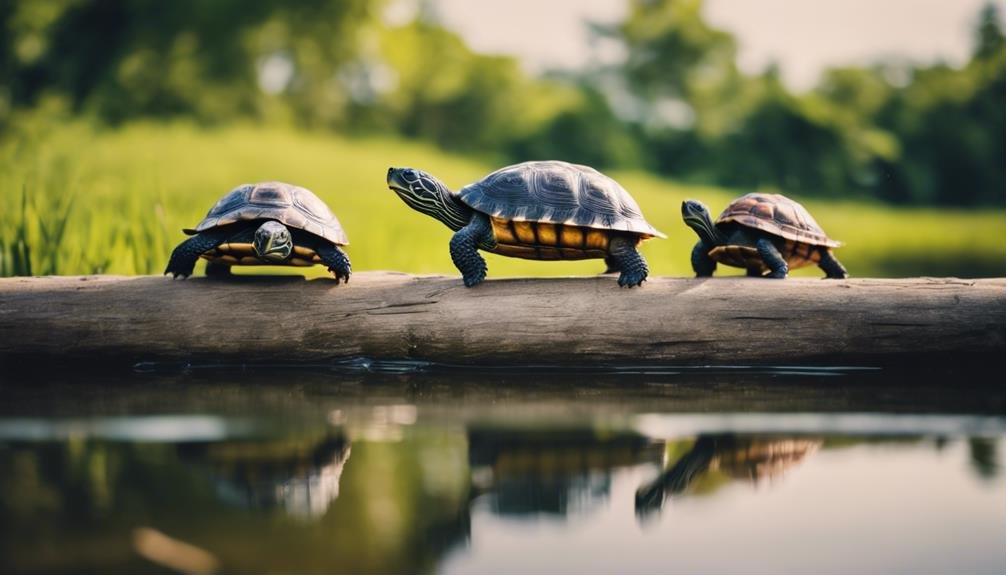

Despite their sturdy appearance, many turtles possess unique physical abilities that might surprise you. While you mightn’t see them leaping over logs, their swimming capabilities are remarkable. Turtles, particularly aquatic species, excel in water; they’re equipped with webbed feet or streamlined flippers that easily propel them through the water. This means they can efficiently chase prey or escape threats in their aquatic environments.
You’ve likely heard debates about the flexibility of a turtle’s shell. While their shells are hard and protective, they aren’t completely rigid. The shell’s structure allows for a certain degree of bending and movement, which is important when manoeuvring underwater or on land. These adaptations ensure that turtles can thrive in various environments, from rivers and lakes to the deep ocean.
Understanding these physical traits helps you appreciate these fascinating creatures’ sheer adaptability and resilience. They’re not just slow-moving, shell-bound animals as often portrayed. Instead, they’ve evolved to meet the demands of their environments impressively. So next time you watch a turtle, note these extraordinary abilities that enable their survival and success in the wild.
Historical Observations of Turtle Movements
Reflecting on their physical traits, we can explore how historical observations have documented turtle movements across various terrains. Even without modern technology, ancient civilizations noted the distinctive patterns of turtle locomotion, leaving us valuable clues in historical texts and fossil records.
- Ancient Turtle Tracks: Numerous sites worldwide boast preserved footprints that reveal turtles’ travel paths. These ancient turtle tracks not only confirm their presence in those regions but also provide insights into the environmental conditions of the time.
- Fossilized Movement Patterns: In some geological strata, you’ll find the fossilized movement patterns of turtles. These patterns help scientists understand the movements turtles could perform millions of years ago, giving a peek into their daily activities and survival strategies.
- Historical Texts and Art: From ancient Egyptian hieroglyphs to Greek texts, turtles are often depicted in a way that highlights their slow but steady movement. These historical documents support the evidence found in physical records like tracks and fossils.
Myths Vs. Reality: Turtle Mobility
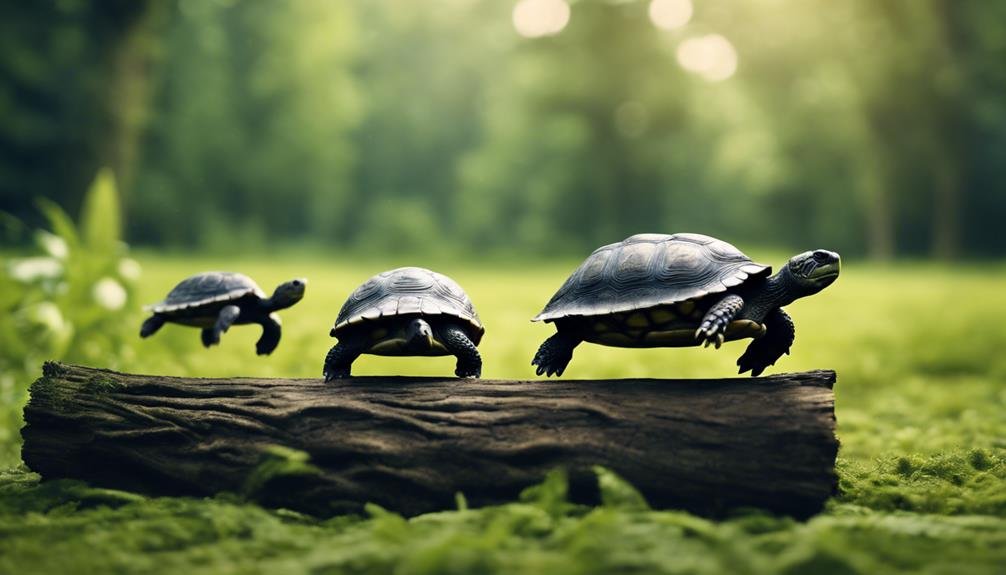

While many myths suggest that turtles can barely move, the reality is that they possess unique adaptations that allow them to navigate their environments effectively. Despite the turtle myths that paint these creatures as sluggish and immobile, you’d be surprised at how capable they are when motivated. Mobility legends often overlook that different species have developed distinct abilities tailored to their specific habitats.
For instance, aquatic turtles aren’t just slow pokes on land; they’re agile and quick in water, using their webbed feet to glide through the water gracefully. On the other hand, terrestrial turtles, though not equipped to win any races, can cover considerable ground when foraging or searching for a mate. You mightn’t see them sprinting, but they’re certainly not as immobile as the myths would have you believe.
Moreover, many believe turtles can’t manoeuvre well due to their shell. However, this isn’t entirely true. The shell provides protection but doesn’t completely hinder their movement. Some turtles can climb small obstacles, manage uneven terrain, and even dig effectively. So, next time you hear someone say turtles can barely move, you’ll know how misleading that statement is.
Scientific Studies on Turtle Locomotion
Recent scientific studies have shed light on how turtles move, revealing surprising agility and strength in various species. You might’ve thought turtles were just slow movers, but researchers are finding out there’s more to their story. These studies focus on ‘locomotion metrics’, which measure how effectively turtles can move in their environments and their movement’s ‘energy efficiency’. This gives scientists valuable insights into their biological capabilities and survival strategies.
Here’s what you need to know about turtle locomotion from the latest research:
- Stride Length and Frequency: Studies have measured turtles’ stride length and frequency, finding that while they may not move fast, their movement is highly purposeful and adapted to conserve energy.
- Energy Expenditure: Turtles optimize their energy use. This means they expend minimal energy per unit of movement, which is essential for survival, especially in resource-scarce environments.
- Adaptive Techniques: Some species have developed unique locomotive techniques to navigate their habitats more effectively. These techniques may not include jumping but certainly involve complex motor coordination.
These findings challenge the old view of turtles as merely slow and awkward. Instead, you see an animal perfectly tuned to its ecological niche, mastering the art of slow and steady survival.
Turtles in Different Environments
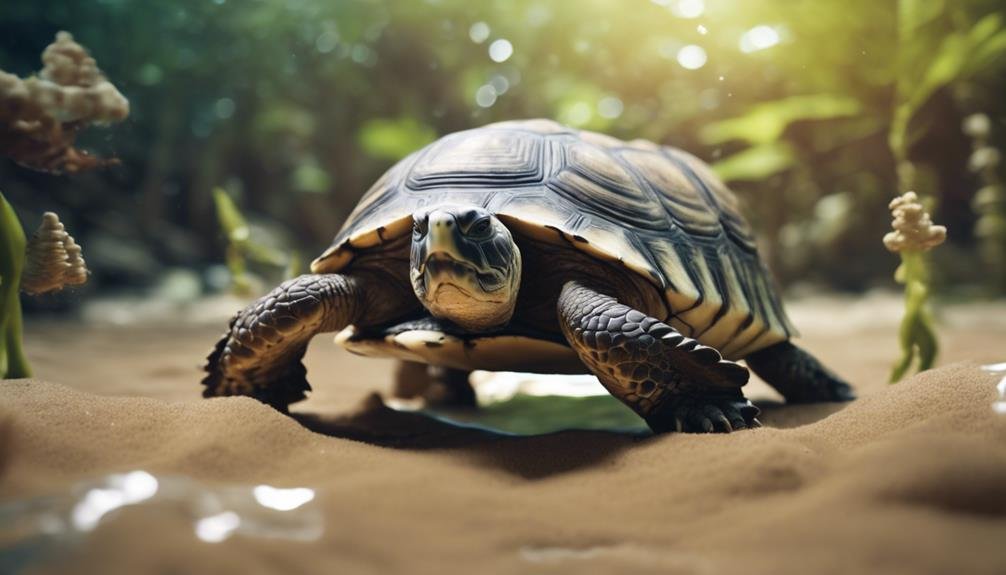

Understanding how turtles move reveals their adaptability, and observing these creatures in different environments highlights their remarkable versatility. You might find turtles slowly meandering through the dense, muddy waters of swamps or gracefully gliding through the salty seas. Each setting demands unique adaptations, which these resilient creatures have mastered beautifully.
In freshwater lakes, turtles thrive on a diet rich in aquatic plants and small fish, while their oceanic cousins might feast on jellyfish and algae. Turtle diets are closely tied to their habitats, and any environmental change can drastically affect what they eat and how they live.
Habitat conservation is essential for maintaining these ecosystems. You can play a role by supporting initiatives protecting turtle habitats from pollution and destruction. Whether it’s a sandy beach where sea turtles nest or a riverbank where freshwater turtles bask, preserving these natural spaces is vital for survival.
As you explore different landscapes, from tropical beaches to urban ponds, remember that each turtle species you encounter has uniquely adapted to its specific environment. Their ability to thrive in varied and sometimes harsh conditions proves their evolutionary success.
Comparing Turtles With Other Reptiles
When delving into turtles compared to other reptiles, they have unique adaptations that distinguish them from snakes, lizards, and crocodiles. It is fascinating how these adaptations align with their survival strategies and lifestyle. Let’s explore some specifics:
- Shell for Protection: Turtles have a hard shell of bony plates called scutes, unlike other reptiles. This shell protects them from predators and influences their habitat preferences. While crocodiles might favour swampy areas and lizards dry rocks, turtles are often found in environments where their shells can provide an advantage against threats.
- Reptile Thermoregulation: Turtles, like all reptiles, are ectothermic, meaning they rely on external heat sources to regulate their body temperature. However, their ability to retreat into their shells allows them a unique method to shield themselves from extreme temperatures, a feature you don’t see in snakes or lizards.
- Aquatic vs. Terrestrial Life: Many turtles are adapted to life in water, which impacts their locomotion and feeding habits. In contrast, most other reptiles, such as snakes and lizards, are primarily terrestrial. This difference in habitat preference has led to distinct physiological and behavioural traits among these creatures.
Understanding these differences can help you appreciate the diversity and complexity of reptile life.
Impact of Age and Health on Mobility
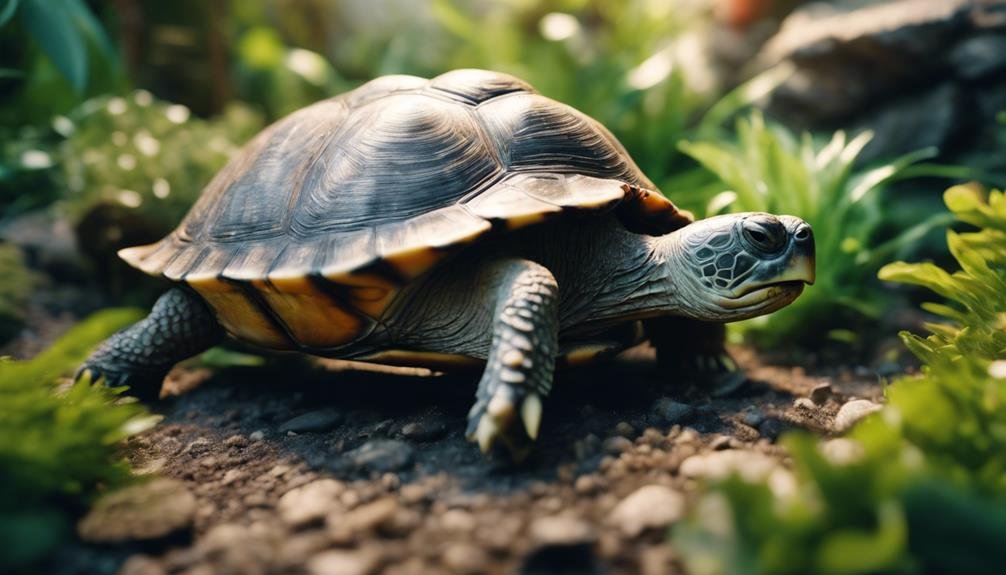

As turtles age or experience health issues, their mobility can be greatly affected. Like humans, turtles can develop age-related arthritis, which limits their movement and may prevent them from performing activities they once did effortlessly. You might notice your turtle moving slower or having difficulty getting around its environment. This is often due to the stiffness and pain associated with arthritis, which tends to worsen with time.
Health-driven adaptability also significantly influences how well turtles cope with these physical challenges. Turtles with good care and adaptive environments can manage better, even with mobility limitations. For instance, modifying their habitat to have lower barriers or providing easier access to food and water can significantly improve their quality of life.
It is important to monitor their activity levels and watch for signs of distress or discomfort. If you see changes, consult with a veterinarian who specializes in reptiles. They can offer treatments that may improve joint function or suggest modifications to the turtle’s lifestyle to help manage symptoms effectively.
Surprising Turtle Behaviors Observed
Turtles often display behaviours that may surprise even experienced reptile enthusiasts. While you mightn’t think these creatures are particularly expressive or active, their unique actions can be fascinating. Here are three surprising behaviours that showcase the complexity of these shelled reptiles:
- Complex Communication: You’d be amazed at how turtles communicate with each other. They use various methods, from touch and vibrations to chemical signals. During mating season, male turtles can become quite vocal, using specific sounds to attract females or deter rivals.
- Ingenious Nesting Habits: Turtle nesting habits are another area where they exhibit unexpected behaviours. Females go to great lengths to protect their eggs, choosing secluded spots and meticulously covering their nests with sand or dirt to disguise them from predators. Some species even return to the beach where they were born to lay their eggs, traversing hundreds of miles of open ocean.
- Unexpected Playfulness: Believe it or not, some turtles exhibit playful behaviour. Researchers have observed turtles interacting with objects in their environment, seemingly just for fun, which is rare in the reptile world.
These behaviours highlight just how intricate and intriguing turtles can be. You’re likely to find their actions as enthralling as any mammal’s.
Conclusion
So, now you know turtles can’t jump like other creatures, but they have unique ways to move and adapt. From swimming to climbing, turtles show off some surprising skills. Don’t be fooled by myths; turtles are more agile than they seem.
Their mobility varies with age, health, and environment. Next time you see a turtle, appreciate its special abilities that help it survive and thrive in its way. Keep an eye out for those unexpected behaviours!
Related Article
https://thereptileguide.com/leopard-gecko-tank-setup/
https://thereptileguide.com/black-snakes-in-arkansas/

